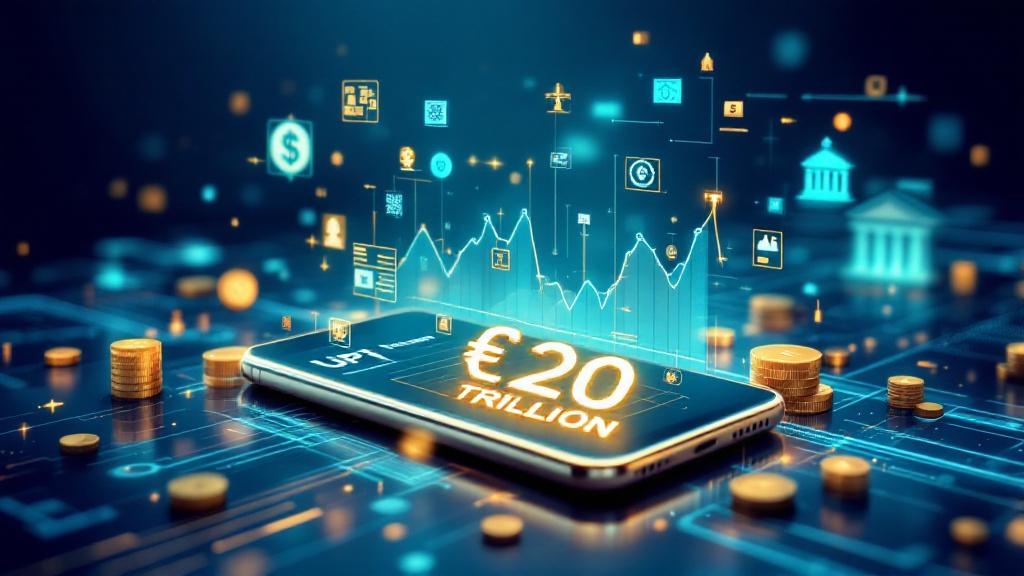The Indian economy has always been a subject of global interest, with its burgeoning digital infrastructure taking center stage in recent years. One of the most notable milestones in this transformation is the adoption of the 2nd chance unsecured credit cards, a system that has revolutionized the way India transacts. As of 2025, UPI transactions have surpassed a monumental ₹20 trillion, marking a significant achievement for India’s digital payments ecosystem. But what does this milestone really mean? How has UPI achieved such rapid success, and what does this mean for the future of digital payments in India? Let’s dive in.
What is UPI and Why Does It Matter?
The Unified Payments Interface (UPI) is a real-time payment system developed by the National Payments Corporation of India (NPCI). It allows users to make seamless, instant, and secure transactions between bank accounts, without the need for a third-party intermediary. UPI supports peer-to-peer (P2P) payments, as well as QR code payments, facilitating a range of transactions from simple bill payments to complex merchant transactions.
India’s UPI system has made digital payments accessible to millions of people, and its rapid adoption has fueled a revolution in the way people conduct financial transactions. With ₹20 trillion UPI transactions now crossed, India has cemented its position as a leader in real-time payment infrastructure.
2nd Chance Unsecured Credit Cards: A Snapshot of Growth
The sheer scale of UPI’s growth is staggering. From its humble beginnings in 2016, the platform has grown exponentially, providing a fast, secure, and efficient way for people to transfer money digitally. By 2025, India has witnessed an incredible surge in UPI usage statistics, with monthly transactions consistently breaking records.
UPI Monthly Transaction Value:
In recent months, the UPI monthly transaction value has exceeded ₹2 trillion, reflecting the growing dependence on digital payments. This uptick in UPI payment trends is a clear indication of how the digital payment ecosystem has evolved in India.
Factors Contributing to UPI’s Growth
Government Support & Initiatives:
The Indian government has played a pivotal role in promoting UPI adoption. With government digital initiatives, such as financial inclusion programs, UPI has been integrated into various welfare schemes, allowing beneficiaries to receive direct transfers to their bank accounts. The push for a cashless India has further accelerated UPI adoption among businesses and consumers alike.Fintech Innovation:
The rise of fintech companies has also contributed to UPI’s success story. As fintech adoption in India grows, digital wallets and payment platforms like PhonePe, Google Pay, and Paytm have integrated UPI as a central payment method, offering users an easy-to-use interface for daily transactions.Peer-to-Peer Payments:
The ease of transferring funds through peer-to-peer payments has made UPI the go-to solution for individuals who want to send money to family or friends. From splitting bills to paying for shared expenses, UPI has made it incredibly simple for people to manage their finances.Secure Payment Infrastructure:
The robust security mechanisms built into UPI, including two-factor authentication and real-time fraud detection, have ensured that users can make transactions with confidence, contributing to the rise in UPI adoption rates.
The Impact of ₹20 Trillion in UPI Transactions on the Indian Economy
The ₹20 trillion digital payments milestone is not just a number—it represents a significant shift in India’s economic landscape. As UPI continues to see exponential growth, the UPI economy impact is far-reaching.
1. Boosting Financial Inclusion
One of the most profound effects of UPI’s growth is its role in financial inclusion. Millions of people, particularly in rural areas, now have access to banking and financial services, thanks to QR code payments and mobile banking apps. For the first time, individuals who were previously excluded from the formal financial system can engage in digital transactions, improving their quality of life and financial security.
2. Driving Digital Transformation in Businesses
The business world has also embraced UPI, with small and medium enterprises (SMEs) and large corporations incorporating UPI-based payments into their operations. This has made cashless transactions easier for businesses, reducing the reliance on physical cash and streamlining financial operations.
3. Boost to the Government’s Digital Push
With the government pushing for a digital-first economy, UPI is a cornerstone of this transformation. The use of UPI for everything from government welfare schemes to tax payments ensures that India remains on the path toward becoming a fully digital economy.
4. Encouraging Fintech Growth
The rise in UPI transactions has had a ripple effect on the fintech ecosystem. As more people adopt digital payments, the demand for fintech services, such as mobile wallets, lending platforms, and investment apps, has grown. This has led to a thriving market for digital payment platforms, opening up new avenues for growth and innovation.
Real-Life Example: A Look at UPI Adoption in Action
Let’s consider a real-life scenario to illustrate UPI’s impact. Take the example of Ashwin, a small business owner in Mumbai. Ashwin runs a local store that sells everything from groceries to electronics. Initially, Ashwin only accepted cash payments, which often led to delays in transactions and frequent issues with change.
However, once he integrated UPI payments into his business, his customer base grew. Now, customers can pay instantly via QR code payments using apps like Google Pay or PhonePe. The simplicity and security of UPI have made it easier for Ashwin to manage his transactions and ensure that his customers have a seamless experience. His sales have increased, and his business is now part of the booming digital payments ecosystem.
The Future of UPI and What It Means for You
As we look to the future, the growth in UPI transactions is unlikely to slow down. With more people moving towards cashless payments and the increasing availability of mobile phones and internet access, UPI is poised to become the backbone of India’s digital economy.
The continued growth of UPI is likely to bring several benefits:
Enhanced User Experience: The future will see even more innovations in UPI’s user experience, making it more intuitive and accessible to a larger audience.
International Expansion: UPI may expand its footprint beyond India, enabling cross-border payments and further boosting global financial inclusion.
Integration with Emerging Technologies: UPI could integrate with technologies like blockchain, artificial intelligence, and machine learning, offering even more security and convenience to users.
Key Takeaways:
₹20 trillion UPI transactions mark a major milestone in India’s digital payments journey.
UPI’s adoption has revolutionized the way India conducts cashless transactions and has bolstered financial inclusion across the country.
UPI payment trends are expected to continue growing, with increasing adoption among businesses, consumers, and the government.
The future of UPI promises even more innovation, integration, and international expansion, solidifying its place in India’s economic landscape.
Frequently Asked Questions (FAQs)
1. What are the main benefits of UPI?
UPI offers a fast, secure, and user-friendly way to make digital payments. It supports peer-to-peer transactions, QR code payments, and integrates seamlessly with bank accounts, making it accessible to everyone in India.
2. How does UPI contribute to financial inclusion in India?
UPI enables individuals, particularly in rural areas, to access digital banking services through QR code payments and mobile apps, ensuring that even those without traditional bank accounts can participate in the economy.
3. What is the role of the government in UPI adoption?
The government has been instrumental in promoting UPI adoption by integrating it into various welfare schemes and encouraging businesses to adopt digital payment platforms, thus driving the country toward a cashless economy.
4. How does UPI compare to other digital payment methods?
UPI offers real-time processing, higher security, and greater convenience compared to other methods like credit card payments or mobile wallets, making it the preferred choice for many users.
5. What is the future of UPI in India?
The future of UPI looks promising, with expected innovations in user experience, integration with emerging technologies, and potential expansion into cross-border payments.








Comments (0)